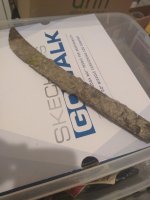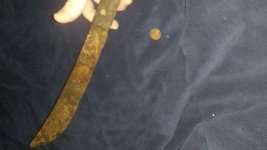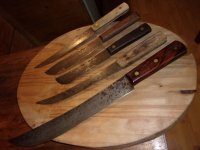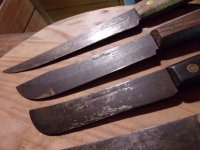Navigation
Install the app
How to install the app on iOS
Follow along with the video below to see how to install our site as a web app on your home screen.
Note: This feature may not be available in some browsers.
More options
You are using an out of date browser. It may not display this or other websites correctly.
You should upgrade or use an alternative browser.
You should upgrade or use an alternative browser.
Okay so, I just found this in the nearby river. Looks antique possibly
- Thread starter Snorlax
- Start date
What size is it?
smallfoot
Bronze Member
- May 29, 2019
- 1,970
- 4,144
- Detector(s) used
- Garrett AT Pro, Bounty Hunter Tracker IV
- Primary Interest:
- All Treasure Hunting
If you run it thru some electrolysis, you may get a pattern of stippling on the blade metal that would indicate some of the popular brands from early 1900s to present. If the blade sides are flat you might have something a little earlier. It's not disappointing to me. You've found a mighty handy artifact. Probably one of man's first tools.
Snorlax
Full Member
- Aug 28, 2017
- 112
- 214
- Detector(s) used
- Teknetics Patriot
Minelab Explorer SE
Makro Racer
- Primary Interest:
- All Treasure Hunting
- Thread starter
- #8
So you believe it's old? I can do more restoration if that'd be of any help with a better potential for an ID. EDIT: looking at it the sides of the blade are very flat with no raising anywhere on the blade visible.
Last edited:
smallfoot
Bronze Member
- May 29, 2019
- 1,970
- 4,144
- Detector(s) used
- Garrett AT Pro, Bounty Hunter Tracker IV
- Primary Interest:
- All Treasure Hunting
I can't really see much trying to blow your pix up gets blurry fast. Hydrolysis would take most of the blade back to where you might see what I'm talking about. Many companies made butcher knives on the same pattern for years and years. They were some very good knives even though they were about as cheap as you could get. I'll grab a few and take some shots to let you see the stipling. They were stamped metal blades. Thin and good carbon steel. Brought to razor sharp very easily. They usually had just straight wood scales attached by machine made brass rivets. I'll be back in a few...
smallfoot
Bronze Member
- May 29, 2019
- 1,970
- 4,144
- Detector(s) used
- Garrett AT Pro, Bounty Hunter Tracker IV
- Primary Interest:
- All Treasure Hunting
These are a few I have. The top 3 knives have the stippling I'm talking about although stippling might not be the correct term. Some of these blades are marked "Forged" but that process means different things to different people I guess. I believe they were stamped from sheets to perimeter shape then sharpened and hardened and tempered.
Lots of the cheaper ones would not have any markings on the blade to determine who made them, but many had the name stamped on the wooden scales...that didn't last long. The steady use of these wore the handles smooth over time. The lines and marks on the blades I believe could aid in IDing if you knew which makers used that certain machine to roll the steel into sheets(or stamped). Further than that you can't really tell much about them unless you have a maker's mark or name of the company stamped into the steel somewhere.
Of these 5, the newest knife is on the bottom. It was given to my Mom in 1953 by my uncle Jessy. It is also the most valuable because of the name..Green River! The oldest is probably the one above the Green River. It is Marked I. Wilson. It's a Sheffield England knife from 1870-90s.
Lots of the cheaper ones would not have any markings on the blade to determine who made them, but many had the name stamped on the wooden scales...that didn't last long. The steady use of these wore the handles smooth over time. The lines and marks on the blades I believe could aid in IDing if you knew which makers used that certain machine to roll the steel into sheets(or stamped). Further than that you can't really tell much about them unless you have a maker's mark or name of the company stamped into the steel somewhere.
Of these 5, the newest knife is on the bottom. It was given to my Mom in 1953 by my uncle Jessy. It is also the most valuable because of the name..Green River! The oldest is probably the one above the Green River. It is Marked I. Wilson. It's a Sheffield England knife from 1870-90s.
Attachments
Last edited:
- May 28, 2010
- 19,742
- 31,069
- 🥇 Banner finds
- 1
- 🏆 Honorable Mentions:
- 1
- Detector(s) used
- Nokta Makro Legend// Pulsedive// Minelab GPZ 7000// Vanquish 540// Minelab Pro Find 35// Dune Kraken Sandscoop// Grave Digger Tools Tombstone shovel & Sidekick digger// Bunk's Hermit Pick
- Primary Interest:
- Metal Detecting
The knife you found is not actually worth anything. It is not pre-1900. Crusty crap is neat to find, but it is not worth the time or effort to "clean up," or "restore." Again, cool find, now throw it in the trash and be done with it! 

smallfoot
Bronze Member
- May 29, 2019
- 1,970
- 4,144
- Detector(s) used
- Garrett AT Pro, Bounty Hunter Tracker IV
- Primary Interest:
- All Treasure Hunting
Terry is right! You can buy a brand new Old hickory or Ontario Knife Company butcher similar to yours for less than $20. Most of the knives we'll find aren't going to be in very good shape if they are old. The good steels back then were carbon steel. Rust takes them away. I've found 7 or 8 pocket knives on the old trail thru here and there's nothing left but some brass bolsters, some thin brass liners, once in a while you might have a piece of handle still surviving. I still think they are cool finds. Whether you feel it's collectible or not is up to you.
Wildcat1750
Gold Member
- Nov 18, 2012
- 5,015
- 4,107
- 🏆 Honorable Mentions:
- 4
- Detector(s) used
- AT PRO/Ace 250w8.5x11" DD Coil/
Garrett Pro-Pointer/Garrett Pro-Pointer AT/
Vibra-Tector 730/
Radio Shack Discovery 1000 (Tracker IV)
- Primary Interest:
- All Treasure Hunting
Interesting find and plenty of suggestions about it here... 

Al D
Bronze Member
Or maybe a murder weapon?Butcher Knife!
sorry, I am just joking because I am bored, nice find though
gunsil
Silver Member
- Dec 27, 2012
- 3,863
- 6,205
- Detector(s) used
- safari, ATPro, infinium, old Garrett BFO, Excal, Nox 800
- Primary Interest:
- All Treasure Hunting
These are a few I have. The top 3 knives have the stippling I'm talking about although stippling might not be the correct term. Some of these blades are marked "Forged" but that process means different things to different people I guess. I believe they were stamped from sheets to perimeter shape then sharpened and hardened and tempered.
Lots of the cheaper ones would not have any markings on the blade to determine who made them, but many had the name stamped on the wooden scales...that didn't last long. The steady use of these wore the handles smooth over time. The lines and marks on the blades I believe could aid in IDing if you knew which makers used that certain machine to roll the steel into sheets(or stamped). Further than that you can't really tell much about them unless you have a maker's mark or name of the company stamped into the steel somewhere.
Of these 5, the newest knife is on the bottom. It was given to my Mom in 1953 by my uncle Jessy. It is also the most valuable because of the name..Green River! The oldest is probably the one above the Green River. It is Marked I. Wilson. It's a Sheffield England knife from 1870-90s.
The "stippling" you refer to was just a ploy by many manufacturers to make people think the knives were hand forged. They were not, the pattern was put in with a rolling press, and this was used mostly from the 1920s-1950s. I can't read the Wilson, but if the word "England" is on it it was made after 1891. In general the large brass rivets are indicative of a newer knife, post 1920s. The "Green River" is nothing special, many companies put that on their knives to imitate the Russell Green River Works knives. Only the Russel Green River Works knives have some value, and in general there are very few who collect old butcher or kitchen knives so they have little value. As Terry says, the OP knife sadly is a junker. I love knives, have antique kitchen and butcher knives and antique steels to keep them sharp but they didn't cost much and aren't worth much. There is some interest in kitchen and butcher knives made by famous companies like Case, KA-BAR, and Russell, but most are worth a couple bucks at any flea market.
Snorlax
Full Member
- Aug 28, 2017
- 112
- 214
- Detector(s) used
- Teknetics Patriot
Minelab Explorer SE
Makro Racer
- Primary Interest:
- All Treasure Hunting
- Thread starter
- #18
So I feel ridiculous due to the fact that my measurement of the item itself was way off due to a horribly inaccurate method taught to me by my family. With a ruler it's roughly just over 14 inches. Not sure if that's info that's real needed for ID but I'd figure to update everyone in case that's of any importance.
- Feb 3, 2009
- 41,377
- 158,400
- 🥇 Banner finds
- 1
- Detector(s) used
- Deus, Deus 2, Minelab 3030, E-Trac,
- Primary Interest:
- Relic Hunting
So I feel ridiculous due to the fact that my measurement of the item itself was way off due to a horribly inaccurate method taught to me by my family. With a ruler it's roughly just over 14 inches. Not sure if that's info that's real needed for ID but I'd figure to update everyone in case that's of any importance.
Don't be-and not to feel anything of the sort.
Finding something is something that has been lost/discarded and that's what the lure of discovering/digging things is all about.
Sharing information, learning things, is a lengthy journey.
Just because you didn't know shows that you're willing to learn and seek out what it is.
I've dug up many blades, I don't throw them, I might try to put an edge back on a few, keep a few for the style.
If everyone just chucked it in the trash as stated by some, what's the point in even exploring in the first place.
smallfoot
Bronze Member
- May 29, 2019
- 1,970
- 4,144
- Detector(s) used
- Garrett AT Pro, Bounty Hunter Tracker IV
- Primary Interest:
- All Treasure Hunting
The "stippling" you refer to was just a ploy by many manufacturers to make people think the knives were hand forged. They were not, the pattern was put in with a rolling press, and this was used mostly from the 1920s-1950s. I can't read the Wilson, but if the word "England" is on it it was made after 1891. In general the large brass rivets are indicative of a newer knife, post 1920s. The "Green River" is nothing special, many companies put that on their knives to imitate the Russell Green River Works knives. Only the Russel Green River Works knives have some value, and in general there are very few who collect old butcher or kitchen knives so they have little value. As Terry says, the OP knife sadly is a junker. I love knives, have antique kitchen and butcher knives and antique steels to keep them sharp but they didn't cost much and aren't worth much. There is some interest in kitchen and butcher knives made by famous companies like Case, KA-BAR, and Russell, but most are worth a couple bucks at any flea market.
Thus my "forged" comment! Laughingly I still stand by my comment that the Green River knife is still the most valuable of all that I posted there. None of my stuff has any real value to anybody but me to be honest.
Top Member Reactions
-
 3521
3521 -
 2087
2087 -
 2043
2043 -
 1155
1155 -
 1116
1116 -
 923
923 -
 849
849 -
 819
819 -
 813
813 -
 779
779 -
 770
770 -
 538
538 -
 531
531 -
 452
452 -
 452
452 -
 446
446 -
E
423
-
 413
413 -
 411
411 -
 404
404
Users who are viewing this thread
Total: 2 (members: 0, guests: 2)








